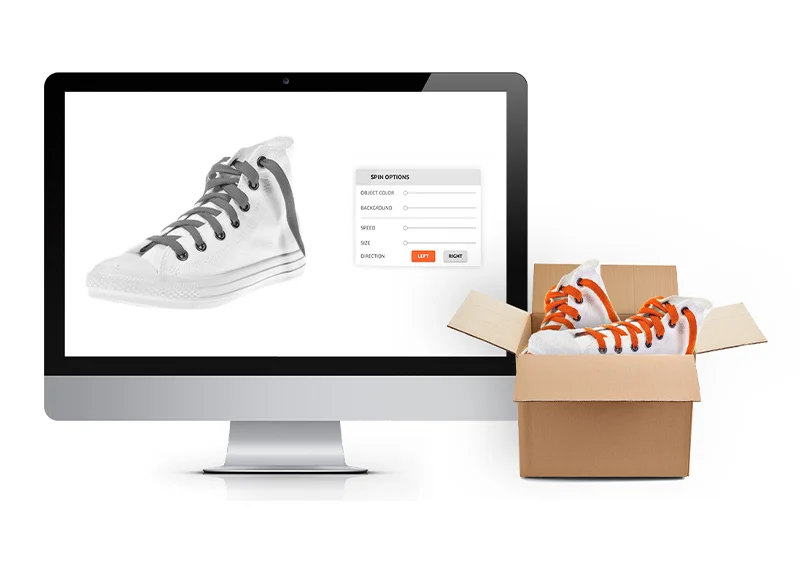Why does 3D product modeling make sense for ecommerce businesses?
The impact of 3D product modeling on eCommerce success.

7 MIN READ
March 11, 2025

Written By
Sasikumar Janakiraman
This is where 3D product modeling changes the game. It enables brands to create lifelike digital models that enhance product visualization, reduce reliance on costly photography, and integrate seamlessly into e-commerce platforms and AR applications. The result is higher engagement, better conversions, and fewer returns.
With e-commerce becoming more competitive, businesses must rethink how they showcase products.
Let’s keep reading to see why 3D modeling for ecommerce is the next big step.
The Changing Consumer Expectations in E-Commerce
E-commerce is no longer just about convenience. Consumers now expect an interactive, immersive, and frictionless shopping experience.
With the rapid adoption of 3D visualization, augmented reality, and AI-driven personalization, brands that fail to adapt risk losing customers to competitors offering a richer, more engaging digital storefront.
To understand why brands need to rethink their online shopping strategy, let’s explore how visual commerce, accurate product representation, and evolving consumer behavior are reshaping e-commerce.
The Rise of Visual Commerce
Consumers are no longer satisfied with static product listings. They want to explore, rotate, and zoom into every detail of a product before committing to a purchase. The days of relying solely on traditional photography are fading—shoppers expect interactive, lifelike experiences.
- 3D models are replacing standard product photos. Instead of showing multiple angles through separate images, brands can now offer 360-degree product views, giving shoppers full control over how they explore an item.
- Augmented reality (AR) bridges the gap between digital and physical shopping. Customers can now place furniture in their home, try on accessories virtually, or see how a product fits into their space before buying.
But simply offering better visuals is not enough. The accuracy and realism of these visuals also play a critical role in shaping purchase decisions.
The Need for Better Product Representation
Shoppers no longer take risks on purchases. They want confidence that what they see online matches what will arrive at their doorstep. The gap between expectation and reality is one of the biggest contributors to cart abandonment and product returns.
- 22% of returns happen because the product looks different in person. Low-quality images and misleading product visuals create hesitation, leading to buyer’s remorse.
- Customization enhances decision-making. When customers can change colors, materials, or styles in real time through a 3D configurator, they feel more in control—resulting in higher purchase confidence.
- Transparency builds trust. Detailed 3D models provide accurate product dimensions, textures, and finishes, reducing uncertainty and increasing customer satisfaction.
Improving product visualization, brands not only attract more buyers but also reduce costly return rates.
But what happens once customers engage with these models? Let’s look at how their behavior changes.
Impact on Buying Behavior
A well-presented product not only looks good—it influences how quickly a consumer makes a decision. When customers can explore a product as if it were physically in front of them, they are more likely to proceed with a purchase.
- Engagement translates to sales. The longer a customer interacts with a product, the higher the chance they will buy it. 3D visualization leads to higher conversion rates because it allows deeper product interaction.
- Omnichannel consistency improves buyer confidence. Whether browsing on a mobile device, desktop, or AR-powered app, consumers expect the product experience to be seamless across platforms.
- Social proof and visualization go hand in hand. Brands that integrate 3D models with customer reviews, AR try-ons, and user-generated content create a stronger emotional connection with buyers—leading to higher trust and faster decision-making.
Brands that invest in 3D product modeling and AR technology are seeing real business impact, higher engagement, reduced return rates, and increased revenue.
6 Benefits of 3D Product Modeling for E-Commerce Businesses
The way a product is presented online has become a deciding factor in whether a customer buys or moves on. With more brands shifting to digital-first selling, 3D product modeling is proving to be a game-changer. It enhances product visualization, customer experience, and overall sales performance.
Let’s explore how 3D product modeling is transforming e-commerce businesses and why brands adopting this technology are seeing tangible results.
1. Unmatched Product Visualization That Builds Buyer Confidence
One of the biggest challenges in e-commerce is bridging the gap between expectation and reality. Shoppers cannot physically touch or inspect products, which often leads to hesitation, abandoned carts, and high return rates.
3D product modeling eliminates this uncertainty.
- Instead of relying on static images, customers can rotate, zoom in, and view a product from every angle.
- Fine details, textures, and material finishes become more apparent, making the product feel real.
- Buyers get a clearer understanding of size, proportions, and design, reducing post-purchase disappointment.
When shoppers can engage with a product in a more immersive way, they feel more confident in their purchase decision.
2. Increased Conversions and Reduced Return Rates
A product that looks realistic online does more than just impress—it sells. Businesses that use 3D product models see higher conversion rates and fewer returns because customers know exactly what they are getting.
- Studies show that 3D visualization can increase conversion rates by up to 40%.
- Detailed, accurate product representation reduces return rates by up to 30%, as customers receive exactly what they expected.
- Buyers spend more time engaging with interactive product visuals, which increases the likelihood of completing a purchase.
By offering a more informative and engaging shopping experience, brands see fewer abandoned carts and higher revenue per visitor.
3. Cost Savings Compared to Traditional Product Photography
For businesses with large inventories or customizable products, traditional product photography is time-consuming and expensive. Every new variation—a different color, material, or configuration—requires another costly photoshoot.
3D product modeling eliminates these inefficiencies.
- A single 3D model can generate unlimited variations without the need for new photography.
- Saves costs on logistics, physical samples, and studio expenses associated with traditional shoots.
- Speeds up product launches since brands can showcase all options instantly, without waiting for physical production.
Instead of continuously investing in photoshoots, businesses can create high-quality 3D assets that scale with their product offerings.
4. Faster Product Customization and Real-Time Variations
Consumers today want personalized shopping experiences. They do not just browse—they interact, compare, and customize.
3D product modeling enables real-time customization, allowing customers to modify products before buying.
- Shoppers can change colors, materials, and finishes in real-time, seeing their customized product instantly.
- No need for multiple product listings—a single 3D model can showcase endless variations.
- This level of customization increases engagement, keeps shoppers on product pages longer, and boosts conversions.
When customers can see exactly what they are creating, they are more likely to complete their purchase.
5. Seamless Integration with AR & VR for Interactive Shopping
Augmented reality and virtual reality are redefining how people shop online. Consumers expect brands to offer interactive experiences that let them visualize products in real-world settings.
- AR-powered shopping experiences allow customers to place 3D products in their homes, helping them make confident decisions.
- Virtual showrooms offer an immersive way to explore products, especially for high-ticket items like furniture, electronics, and fashion.
- Brands like IKEA, Wayfair, and Sephora have already integrated AR shopping, setting new industry standards.
With AR and VR becoming more accessible, 3D product modeling is the foundation for these next-gen shopping experiences.
6. Competitive Differentiation in a Crowded Market
The e-commerce space is saturated. Shoppers have countless options, and standing out requires more than just great products. Brands need to offer something unique and engaging, and 3D product modeling provides exactly that.
- High-quality 3D visuals set brands apart from competitors still relying on flat images.
- An interactive experience creates a memorable shopping journey, leading to stronger brand recall.
- 3D configurators and AR tools give customers something no traditional listing can match, full product control before they buy.
Final Thoughts
A great product is no longer enough to guarantee sales in e-commerce. How you present it online makes all the difference. Shoppers today expect more than just a few static images, they want to see, rotate, zoom in, and even place the product in their space before buying.
3D product modeling is solving this gap. It allows brands to showcase products in incredible detail, offering customers an interactive experience that feels almost as real as shopping in-store. Instead of relying on expensive photography for every variation, businesses can create high-quality, scalable digital assets that work across e-commerce platforms, AR shopping, and marketing campaigns.
For brands that want to sell smarter, reduce returns, and create a more immersive shopping experience, 3D modeling is the future.
And if you're ready to bring that future to your e-commerce business, ZealousXR is here to help.
About the writer :
Sasikumar Janakiraman, as the Creative Director at Zealous Services, brings a unique mix of creativity and technical ... skill. He’s passionate about 2D and 3D design, leading teams to create stunning 3D models and visualizations. Sasikumar loves working closely with clients, making sure their ideas come to life in the best possible way. His goal? To make design feel simple and exciting.
Read MoreFrequently Asked Questions (FAQ)
How does 3D product modeling improve online sales?
3D models create a more engaging shopping experience by allowing customers to view products from every angle, zoom in on details, and interact with different variations in real-time. This builds confidence in the purchase, leading to higher conversion rates and fewer abandoned carts.
Is 3D product modeling cost-effective compared to traditional photography?
Yes. While traditional product photography requires multiple photoshoots for different angles, colors, and configurations, a single 3D model can generate unlimited variations without additional costs. This reduces logistics expenses, reshoots, and time delays, making 3D modeling a more cost-efficient solution.
Can 3D models be used for augmented reality (AR) shopping?
Absolutely. 3D models are the foundation of AR-powered shopping experiences. Customers can place virtual furniture in their homes, try on accessories, or visualize products in real-world settings before making a purchase. This enhances confidence and reduces return rates.
How does 3D modeling help reduce return rates in e-commerce?
Many returns happen because the product does not match customer expectations. With 3D models, customers get a highly accurate, realistic representation of the product, including textures, dimensions, and finishes. This eliminates surprises upon delivery, leading to fewer returns and improved customer satisfaction.
How can I integrate 3D product models into my e-commerce platform?
Most major e-commerce platforms, including Shopify, WooCommerce, and Magento, support 3D models and AR experiences. ZealousXR provides high-quality, optimized 3D models that integrate seamlessly across websites, mobile apps, and AR tools.